#dnd random encounters
Text
Fairy Market Battle Map
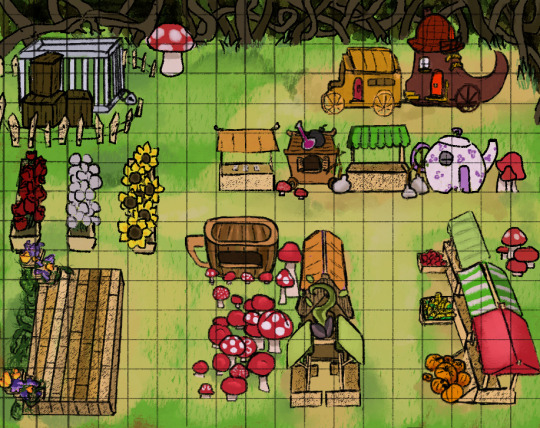
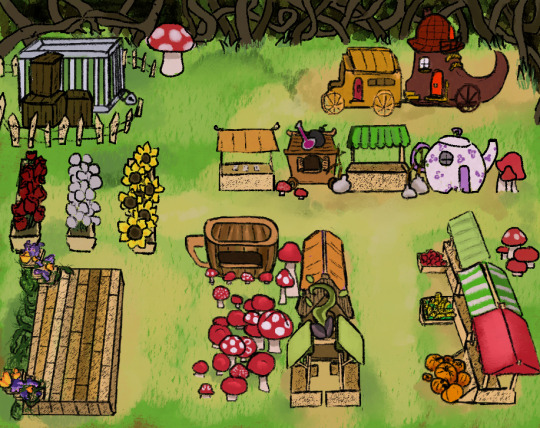
#ttrpg#dnd#dungeons and dragons#fairy market#marketplace#dnd random encounters#5e#5e map#dnd map#ttrpg map#battle map
10 notes
·
View notes
Text
In Praise of Random Encounters
I'm in my "responding to frequently asked Reddit r/rpg questions" phase, so please allow me to defend the random encounter. This post is in response to everyone who goes, "Why do people use random encounters? They interrupt the flow of the story, and it doesn't make any sense to have something randomly show up and fight."

Did you know there was a Pokemon named after me?
In this post, I will argue against these strawmen, make a case for random encounters in certain games, and describe my favorite random encounter situations from my own games.
This disputation against random encounters can be broken up into three parts:
they interrupt what is already going on ("the story")
they are illogical
they're automatically a fight
I'm going to address these last to first.
Random encounters shouldn't jump right into fights. If used as intended, they come with an encounter distance, meaning sometimes you just see signs of the encounter, or you spot them from far away. And they should also come with what used to be called a reaction roll, which dictates how the encounter feels about the PCs. These were rolled on 2d6, which meant there was a bell curve that favored results in the 6-8 range, which were usually something like "wary" or "neutral."
Second, the logic of random encounters. If you're using them right, random encounters should make sense. They should only have a chance of happening in places where the encounters could be, and encounter tables ought to be chosen based on location. So you won't get a dire trout in a desert or whatever.
This last bit is the hardest one. If it feels like a random encounter would disrupt "your story," you're probably running a game whose underlying philosophies are opposed to random encounters, yes. It's probably also opposed to many other frameworks that were present in traditional/old-school rule sets. If your game has a pre-planned story or plot, if that plot requires a certain pace or order, and if the injection of outside elements would disrupt that plot, you probably shouldn't use random encounters.
(You also shouldn't use D&D or its cousins. You might also not want to have other players, since they can disrupt those plots. But that's just me being petty.)
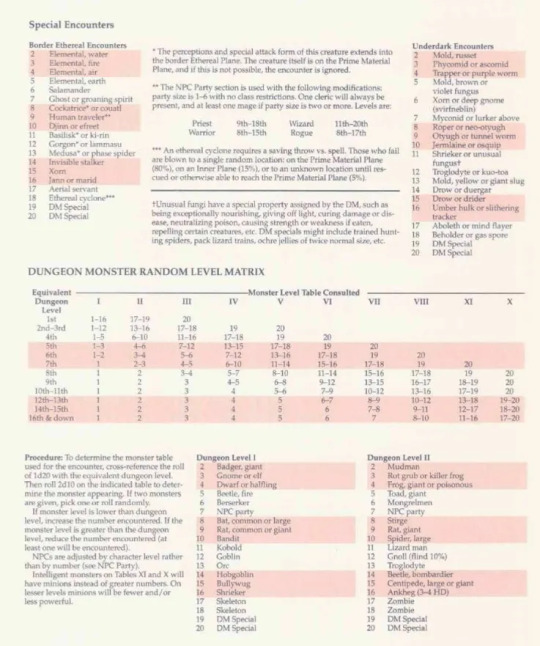
A page of random encounter rules from Advanced Dungeons & Dragons. This is a shitty example. I promise it's easier than this.
So when SHOULD you use random encounters? Use them if the game you're running is attempting to simulate a world that has its own logic and background that is not dependent on the player characters. Random encounters help show that the world is in motion at all times and that people and creatures move about of their own volition. They don't show up when it's meaningful to the plot or the other characters; they wander. They're random.
Another key component of this style of gaming is that they usually consider story as something that emerges from or comes after play. "Remember how we tried to cross the raging river full of electric eels, and you dropped your sword, and I almost died, but we made it across? That was awesome." These things didn't happen because they were important plot points predicted by the DM; they are the results of rolls at the table, rolls that are honored in their immediacy and only made sense of after the fact. Does this mean that you risk having a disjointed mess from which no pleasing story can emerge? Yes! But you also risk having a story emerge that no one could have planned, that is equally surprising and pleasing to everyone at the table.
This emergent storytelling is probably the greatest joy of the random encounter. Don't approach the encounter with, "It doesn't make sense that a goblin would be here." Instead, adopt the attitude of, "Let's figure out why this gobllin would be here." (And while you're at it, use that same attitude toward books you read and movies you see.)
A related aside: in some play cultures, the DM is considered to be someone who plans everything out and slowly reveals bits of story as rewards to the other players. As a DM, this can feel really stagnant, and it can be a lot to keep track of, and there is far less joy of surprise. Using dice at the table to introduce new elements can bring some of that fun back to the DM.
Everything I've said so far is a synthesis of dozens of rulebooks and blog posts I've read across a decade of running games, so please allow me to introduce a final element: my own experience with the joy of random tables.
In 2014, when 5E was coming out to great demand on the backs of Stranger Things, Critical Roll, and The Adventure Zone, I started running a campaign for friends and coworkers. There was no developed play culture around 5E at the time, no cottage industry of third-party developers. So in running it, I was drawing on what I had been reading for years: old-school roleplaying and story games.
So I prepped my starting town (doing way more work that I would today), including random encounter tables for the area. And when the players were out searching for some ruins and getting lost west of town, I rolled a random encounter. It was some gnomes. All the gnomes here had escaped from a gnome hell for greed, so they weren't exactly kind. And their reaction roll was just south of neutral, so they were a little surly.

A bad screenshot of my "west of the town of Wall" encounter tables.
They led the players to the ruins and waited, trying to trap them inside after they'd been run down by the undead inside. But the players overcame the trap and told the gnomes off. (They didn't want to get in another fight after going through the ruins; more emergent storytelling.) So the gnomes ran off, but they would remember this.
Flash forward to a different session. In the main mega-dungeon under the town, the players were exploring a new area. Another random encounter: the devil of gnome hell! It was a giant mole with masses of earthworms for limbs, and it was searching for its escaped prisoners. It threatened to kill the PCs unless they gave it a magical item. So Pepper the elf gave up his winged sword, which he'd found in the aforementioned ruins. He loved that sword.
And here's where it all comes together. The gnomes were trying to settle the land west of town, but the humans had a fort there. The players were going to that fort to get some information about the faerie realms. How could I show this situation in a way that would, as succinctly as possible, illustrate the tension while giving the players a choice on who to join? Well, the gnomes would be attacking the fort. This normally wouldn't be much of a battle…but the vengeful gnome from the ruins had made a deal with the gnome devil for power. And now he was wielding Pepper's sword, using it to fly over the fort walls and attack.
Pepper was pissed! He wanted his sword back! The other players were more interested in figuring out a way to stop the ongoing conflict between gnomes and humans. And the gnomes were split between wanting to peacefully settle their new land and get revenge on the players for driving them off from the ruins. Who would prevail?
I hadn't planned a story, but I had created a situation a story was likely to emerge based on the players' actions and the results of the dice.
Conclusion
This isn't me saying this is the only way to play. It's not the only way I play. In a short one-shot or a tightly paced, emotional game, I would never use random encounters. But they can be fun! And they (and their associated suite of rules) can address some of the issues that lead to DM burnout and genre predictability.

If you find me in the wilderness, I will fight you.
296 notes
·
View notes
Photo

DM Tip: Better Random Encounters
One of the most important steps I made in my journey to becoming a good dungeonmaster was realizing that quite a lot of the system I was learning and the popular advice surrounding it was absolute garbage. 5 to 8 encounters per adventuring day? Encumbrance? Many of these things were holdovers from the days when the game consisted solely of dungeon crawling until level 10, and had no bearing on the character centric narrative adventure game I was wanting to play.
Random encounters were one of those holdovers: an expectation that every dungeon, wilderness location, and even city should have it’s own list ( level appropriate or not) of various challenges and random sights that the party should roll for by day or hour as long as they were playing the game. Specifically, they’re a holdover from a time when random encounters were the main way that players would find these sights and challenges, as much of the gameplay was otherwise about exploring a large ( and mostly empty) map of a dungeon or landscape. This is where the idea about 5-8 encounters per day really comes from.
The real problem is that encounters these days are quite a lot of work, both in that the DM has to put a lot of energy into making each encounter entertaining/challenging AND that any potential combat or RP is going to eat up a lot of table time. The workload for DMs is compounded by the fact that if the party isn’t having frequent random encounters in the same area, a good portion of their prep work is wasted, which begs the question of why do random encounters at all and not just concentrate all their efforts on one or two really good encounters? This is the route I’ve seen most groups take , leaving random encounters as obligatory filler, if they use it at all.
But what if you still like the idea of random encounters? Well below the cut I’m going to show you not only how to design encounters that take advantage of an element of randomness while still keeping that focused feel, and over here I’ll talk about how to design adventures that embody that element of discovery random encounters were supposed to facilitate in the first place.
The Jack-in-the-Box Encounter: Imagine that your party has crept into the lair of some terrifying monster in pursuit of their current goal, perhaps they’re looting a ruin, or recovering a mcguffin, or rescuing an abducted npc. They know that if they stay too long, the monster will discover them and they’ll have to face down a foe that far exceeds their current strength so they need to be smart, cautious, and fast, despite seldom being any one of these things. Allow them to explore the lair freely but every time they make noise or take a lot of time doing something, you throw a d6 into a cup or small bowl in a way that -plinks- ominously. Six dice in the bowl? Roll them, and if the number 6 comes up, the beast has arrived and the heroes have a hell of a fight on their hands.
This method of encounterbuilding allows you to have a threat looming over the party’s heads, acting like a clock that ticks forward whenever they move. The best part is that it’s possible to get to the limit of six dice and not have the jack-in-the-box encounter trigger, meaning that their luck holds out. if you want to give them extra wiggle room ( such as if they have to explore a whole dungeon without alerting the boss) you could do a countdown system, three 6 needed to pass on their first trigger, then only two, then one on every subsequent throw.
Whether or not the enemy announces itself when triggered is entirely dependant on how you want the encounter to play out: A giant might thunderously return home giving the party one last chance to dive for cover before they’re spotted, while a shadowy wraith might stalk the party from the darkness, waiting for the perfect time to strike under the pretenses that the count is still continuing.
You could also use this to represent a bountyhunter tracking down the party over the course of weeks, getting just a bit closer every time they give themselves away.
#dnd#dungeons and dragons#d&d#5e#pathfinder#ttrpg#homebrew mechanic#dm tips#dm advice#dm tip#dm tools#writing advice#DnD Mechanics#random encounters
379 notes
·
View notes
Text
I Am Too Damn Tired To Be Fighting For My Life Like This Right Now
#captain's posts#i need to take a piss but now im on a dnd random encounter with the biggest wolf spider ive ever seen#ive got a can of raid within yoinking distance but this fucker looks willing to fight me if i mace it#he is blocking the only exit damn it
23 notes
·
View notes
Photo
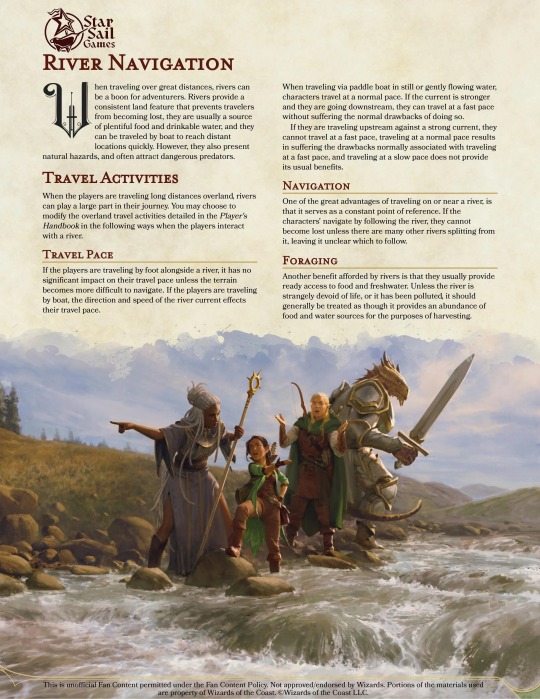

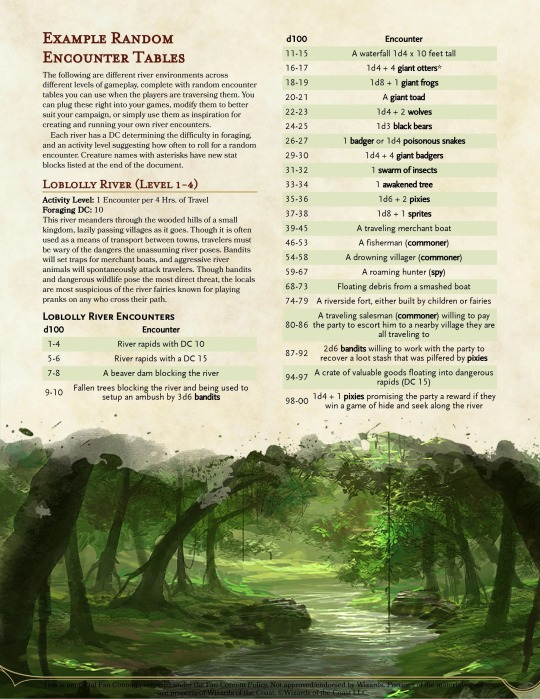



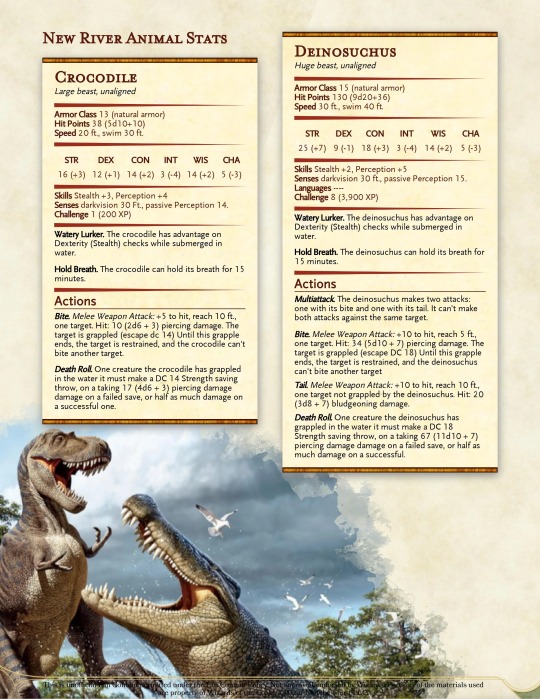
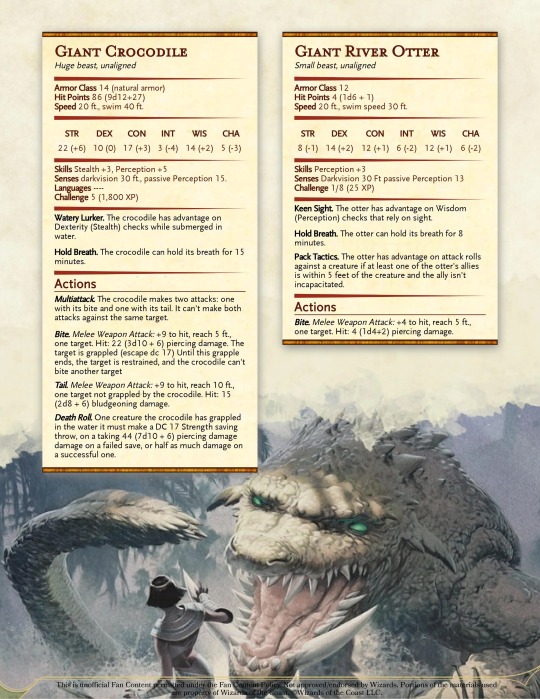
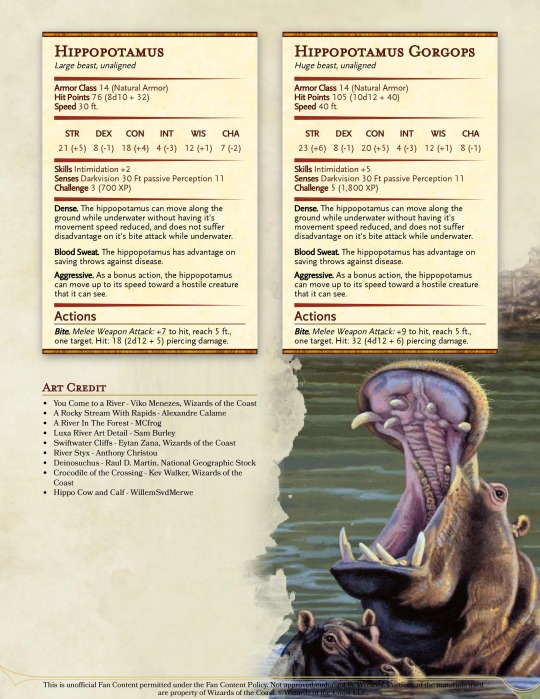
River Navigation: Tools to Help You Run River Adventures by StarSailGames on reddit
206 notes
·
View notes
Text
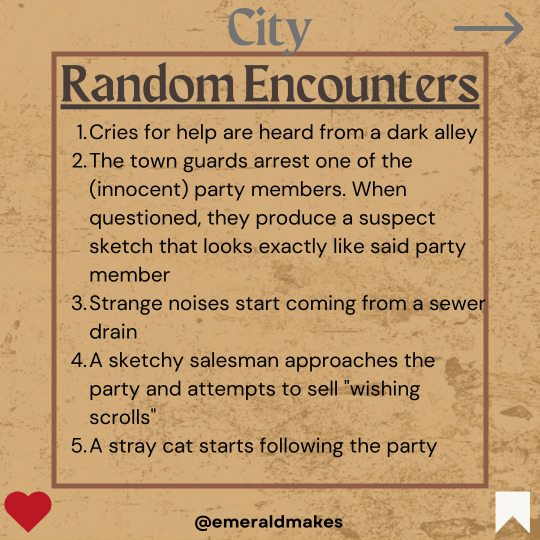
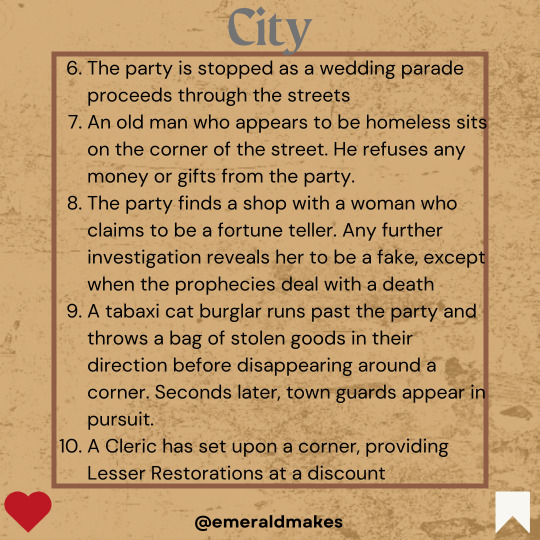
🏙 𝘾𝙞𝙩𝙮 𝙍𝙖𝙣𝙙𝙤𝙢 𝙀𝙣𝙘𝙤𝙪𝙣𝙩𝙚𝙧𝙨 🌃
Cities are filled with a mix of people with different motives and morals. Who knows what could happen with that many people in one space.
1. Cries for help are heard from a dark alley
2. The town guards arrest one of the (innocent) party members. When questioned, they produce a suspect sketch that looks exactly like said party member
3. Strange noises start coming from a sewer drain
4. A sketchy salesman approaches the party and attempts to sell "wishing scrolls"
5. A stray cat starts following the party
6. The party is stopped as a wedding parade proceeds through the streets
7. An old man who appears to be homeless sits on the corner of the street. He refuses any money or gifts from the party
8. The party finds a shop with a woman who claims to be a fortune teller. Any further investigation reveals her to be a fake, except when the prophecies involve a death
9. A tabaxi cat burglar runs past the party and throws a bag of stolen goods in their direction before disappearing around a corner. Seconds later, town guards appear in pursuit.
10. A Cleric has set up on a corner, providing Lesser Restorations at a discounted price
#dnd#5e#ttrpg#d&d#dungeons and dragons#rpg#dm tips#critical role#taz#roll table#random encounter#city
173 notes
·
View notes
Text


Hello, here is a more refined version of this idea from a while ago. Just formatted in a little print-out-style page. It could definitely still use some tlc, but I love the idea of the Brain in a Jar NPC.
#dnd#dungeons and dragons#dnd5e#dnd one shot#one shot#dungeons and dragons one shot#dnd ideas#random encounters#dnd random encounter#dnd monsters
20 notes
·
View notes
Text
The bullywug mating call being Emily’s idea makes it so much better.
#don’t try and figure out my listening habits. just don’t#the encounter tournament is ruining my reputation bc I keep posting the most random shit#naddpod#not another dnd podcast#bahumia#emily axford
24 notes
·
View notes
Text
I just improvised like half of a dnd session and STILL managed to get the plot going where I need it to, in a COMPLETELY different way than I thought I was going to get that information, got the party to COMMUNICATE with each other, and introduced a BOOKSTORE GHOST WITH A CAT WHO MADE A DEAL WITH A PLAYER THAT SHE WOULD COME BACK AND TELL HER THE REST OF HER STORY bc they’re in an apocalypse so there are no more books to read and aaaaa
Now I get to design a mini dungeon for the players to steal a car from the neighborhood dealership that has been turned into a home base for the gang of republican dads who are also trying to survive this zombie apocalypse
#I get to flesh out the Waffle House secret society even more because of a 24 persuasion check#and I get to use the random encounters I’ve been saving up for the road trip they’re finally going on!! to north New Mexico and beyond!!!#I realize this campaign makes absolutely no sense to anyone who doesn’t already know what’s going on and I love it#AND in my panic I still managed to get the party moving northwest; which is EXACTLY where I need them to go for Plot Stuff (if ur in the-#campaign and ur reading this ignore it) hfgdghf#dnd#waffle texas failures#dungeons and dragons#dnd dm#dnd campaign#d&d
33 notes
·
View notes
Text
1d6 Caves to Plunder
The smugglers’ hideout - A cave that is used by a band of smugglers. Even if they don’t all live in this cave, they keep an active guard here. Treasure in this cave includes stashes of illegal and stolen goods. Dangers here include the scoundrels themselves, as well as traps they may have set to ward off intruders.
The dragon’s nest - A cave that is home to a dragon. Treasure includes the dragon’s hoard, which may just be a big pile of gold or may be in the form of gems, art, or some other valuable object. Dangers here include the monster itself, as well as weaker minions that are in its service.
The bright maze - This cave is so dense with crystals that the sunlight pouring through its many openings turns it a blindingly bright. Treasure in this cave includes precious gems and crystals that occur naturally in the cave. Dangers here include getting lost among the twists and turns of branching crystal pathways, as well as other natural cave hazards such as steep drops, cave-ins, and chambers where the air is too thin or poisoned to breathe.
The assassins’ den - A cave where a group of assassins meet to plan their next hit. Treasure includes coin that has been paid to the assassins for their work, and high quality weapons that they store here. Dangers here include being caught by the assassins now, or being found out by them and becoming their next targets.
The mage’s lair - A cave used by a master of the arcane arts as a secluded place to perform magical experiments. Treasure includes magical items and arcane knowledge (in the form of spellbooks or scrolls, or other tomes of research). Dangers here include the mage and their arcane experiments, as well as magical traps and beings they have summoned or animated to defend their lair.
The cursed cavern - In this cave dwell a number of restless spirits and unexplained phenomena. Treasure can be found in a wide variety: coins, gems, magical items, art and trinkets and more. Dangers here include violent spirits, confusion or madness, and cursed treasure.
#random table#random tables#ttrpg#ttrpg community#ttrpg homebrew#homebrew#fantasy#dnd#d&d#dungeons and dragons#dnd homebrew#dnd table#locations#places#random location table#random encounter table
78 notes
·
View notes
Text
I'm loving Dungeon Meshi so much right now!!! It's had my attention since episode 1 with the humor and tendril ecology bit, but because there's such an excess of rpg-like series out there, I wasn't sold instantly. I'm also a bit confused because I've seen multiple people claim the living armor episode as the one that sells the series to others, because I thought it was the most boring one??? and it was episodes 5-6 that won me over, or provided me with enough build up to convince me it's a series worth sticking with.
#my nonsense#ella watches anime#dungeon meshi#i'm so in love with all the characters#it truly feels like a dnd game#with all the down time#that allows you to get to know the characters#but also having such specific encounters???#for some reason that feels pretty rare??? or other anime don't make the random attacks feel like rpg enounters the way dunmeshi does
8 notes
·
View notes
Text



oh brother who invited this guy
#barely even bothering to fully tag this#dnd oc#bg3 oc#oc:thirteen#mystra#mystra bg3#this isnt even. any of my player characters or anything.#it's my character rubi's patron. LOL.#technically took them from a dnd campaign i actually played but they fit the bill for what i had in mind for rubis patron so#congrats to thirteen for terrorizing two of my guy's lives#if you look far enough into this blog's archives you'll find an older design of them too#also 2 be clear the skeleton form is their main form they just shift form alot#i imagine when encountering rubi for the first time they popped up in their teifling form to have rubi trust them more easily#since (keep in mind. im still thinking of rubis backstory as i write this lmao) i imagine rubi grew up somewhere where there werent many#other teiflings#anyways. hope yall enjoyed this random tag dump#sketches#idk if ill make this more than just a funny haha bit but its funny to imagine mystra and thirteen as WORSTIESSS bc it makes -#the rubigale dynamic funnier to me. but well see if i properly commit or not#oc art#bg3
10 notes
·
View notes
Text
Random encounter
As you traips through the dungeon. now alone. you come across a large machine attended by a well dressed goblin. “Welcome to the immortality machine.” it utters “It will allow you eternal life more or less. but only if you can bring yourself to use it.“ Skeptical of anything sold by a goblin you enquire about the price of such a device. “No price, just a list of instructions. everytime you use the machine you will de aged to that of a 14 year old child. you will remember everything thats happened and your experiences will make you stronger, smarter and wiser beyond your original capabilitys. but every time you return you must be stronger than last time or it will kill you.“ you know it wouldn't be true immortality if you had to be stronger each time. eventually you wont be able to get stronger. at least you think. you ask the goblin why he would offer such a device to you. “Mortals are easily tempted.“ it answered slyly.
17 notes
·
View notes
Photo

Drafting the Adventure: Wilderness and Exploration
For a game with exploration as one of it’s “core pillars”, d&d is kinda shit at producing gameplay conducive to actually making players feel like they’re exploring.If you play it by the book travelling from point A to B often feels like a slog, and a good number of groups are completely justified in skipping it entirely and just getting to the good bits. I think the problem largely stems from trying to cram the hexcrawl/westmarches style of gameplay from d&d’s heyday into the central gameplay loop when really it should be the focus of very particular kinds of adventure. Think of a big exploration adventure the same way you’d run a heist or murder mystery, usually a one off unless you’re running a specialized campaign.
With that said, the base rules for hanging out in the wilderness are IMO in massive need of an overhaul, so we might as well overhaul those along with setting up a good guidelines for running an exploration based adventure. Before we dive under the hood and get into all those storybuilding steps and mechanics, lets look at how my system works from the players’ perspective:
In lieu of any urgent quests or fantastic job offers, a group of adventurers decide they’re going to explore the wilderness outside their settlement and look for some opportunities.
One character chats up the locals, hearing rumours of what might be going on outside the walls. The second does some research on the area and finds a few trustworthy maps to copy. Another checks the local bountyboard for outlaws and monsters it might pay to hunt down.
The party sets out, and the DM asks the party which player wants to be the group’s surveyor: keeping a list of what places the party has visited, what options are available to them, and what might need a bit more exploration.
The DM has divided the area they’re exploring into zones with names like “The forbidden peaks” or “ The merry meadows” which gives each area a strong geographic identity and makes it easy for the party to remember and gives them an idea of what to expect.
Every time the party walks into a new zone, they learn the area’s name, and how many “points of interest” are in that region. A point of interest could be anything from a unique environmental detail to the lead in to an encounter to a monster lair to the entrance to a whole dungeon. The surveyor keeps track of these points of interest, making space to write in whatever details they think are relevant.
Likewise upon entering into a new zone, the party are made aware of “landmarks” striking points of interest that are obvious to the naked eye and don’t need to be searched for. Because this group prepared before they left, they’ll likely have learned of a few more points of interest in the region based off the information they gathered.
When the party have fully explored a point of interest, the DM tells the surveyor to check off the name of that location, indicating that it’s safe and that the party can turn their attention elsewhere
When deciding where to go next, the party has two options: Set out for a specific area (one they know about or have visited before) or to Wander, poking around till they find a location they didn’t know about previously. The DM may ask for checks while the party is traveling based on the difficulty of reaching the point of interest or the particulars of the zone they’re travelling through.
Because the DM has been upfront with how many points of interest are in the zone, the party have an understandable goal of filling in a list and checking off each location. This feels like actual exploration because the party is actually making the decision of where to go and how deep to search, combining those key elements of choice and discovery that make setting out into the unknown so rewarding.
Below the cut I’m going to go into detail about how to BUILD an exploration adventure, everything from designing goals to fit your narrative needs to choosing what kind of points of interest to seed into the world .
First step: Setting Bounderies
When preparing a wilderness adventure, you’re going to settle on an area that the party is exploring and why: are they low level nobodies knocking about the countryside surrounding the starting village till the call to adventure finds them? Are they high level heroes looking to comb a vast wasteland for the location of a forgotten temple? Are they desperate survivors battling the elements as they attempt to find a pass through the deep wilderness? Obviously these will set the scale and tone of your adventure, but they’ll also help you define your boundaries: are your party moving towards a specific goal, or are they fucking around? Are they able to return to the comforts of civilization on the regular, or are they on their own? Is their exploration more of a self driven sandbox, or are they trying to find a route to a particular destination fellowship style.
Perhaps most importantly you need to ask: SHOULD this adventure be exploration focused? These sorts of adventures are a lot of work and if the party is only going to go through this region once you might be better served by just planning some encounters and pantomiming the idea of exploration in your narration.
Second step: Zoning it out
Now that you’ve settled on your region, you’re going to start cutting it up into Zones, large areas with a distinct geographic identity that will stick in your party’s mind: the area around a village might be divided by its cardinal points into fields, swamp, forest, and hills, able to be explored in any order, where as an attempt to cross the mountains might be separated into a sequence of 1) foothills 2) a choice between peaks OR caverns 3) river 4) lake. Obviously you’ll give each zone a striking name as you develop its theme that will help reinforce its identity by the time you present this to the party. I’d recommend three to six zones, as any more than that it gets hard to differentiate them from eachother.
Third step: Making lists
Now comes the fun part in designing your points of interest. I’ve found this is a two part process of brainstorming physical locations within each zone and determining what sort of encounters might happen there, though often times the latter comes before the former. It’s important to remember that an encounter is more than a fight, and fights are more than just face to face combat. Here’s some ideas to get your brainstorming started:
Generally you’ll want atleast four and a maximum of twelve points of interest per zone ( though I tend to default to six) this is not only to prevent you from having to make too much content, but also to be able to use a die to determine what random point of interest the party finds when wandering. Every 2 locations they check off your list, decrease the die size.
Between landmarks and information that a party can gather through rumour/studying maps, I’d advise having no more than half your Zone’s content discoverable before the party actually starts wandering. This is to preserve the sense of the unknown which is vital to feeling like exploration means something.
Landmarks are like billboards drawing your party to particular content, ranging from natural features like hills or rivers to ruins or statues. Use them to deliver details the party should know about the zone early.
Trails or other signs of habitation are your friend, as they allow you to tease what an encounter MIGHT be without giving things away immediately; bandit ambushes, lost travellers, local wildlife, all of these could be at the end of a trail, but it’s far easier for you to bait the party with their own curiosity than come with an obvious “this place looks like a trap, do you want to step in it?”
When it actually comes to combat encounters, I’d advise balancing how challenging the encounter is with how much forewarning the party has. Ambushes they walk right into should be easy or very easy, while medium and hard encounters should either be opt in ( seeking out a beast in its lair) or avoidable ( hiding while the chimera circles overhead)
Points of interest can have many things to discover within them, such as frontier settlements, or Structures and Caverns which can be run as small dungeons.
Some locations may act as gateways into different zones. This is particularly useful for overland travel adventures where the party has to find the right point of interest to lead them on to the next phase of their journey.
For longer explorations it’s a good idea to include “safeholds”, places the party can use as a campsite rather than roughing it in the wilderness an being exposed to the elements or the threat of random encounters.
Puzzles and scavenger hunts are amazing activities at points of interest, especially if the party needs to go somewhere else in the zone/area to solve them.
Need to express that one particular point of interest ( or perhaps a whole zone) is difficult to traverse? Have the party roll con saves to avoid exhaustion/survival checks to find a better route. You can likewise do this with stealth checks to avoid the patrol routes of enemies or the hunting grounds of vicious predators.
#dnd#dungeons and dragons#d&d#5e#pathfinder#ttrpg#dm advice#dm tip#dm tips#dm tools#writing advice#homebrew#DnD Mechanics#d&d mechanics#homebrew mechanic#Wilderness#exploration#random encounters
314 notes
·
View notes
Text
catching up on tet rn,
WHAT DO YOU MEAN HE CUT OFF CATHYS ARM.
STOP 😔
#the encounter table#crying rn#they actually need to stop#random dnd podcast making me cry for what reason
6 notes
·
View notes
Text


Tavern Encounters by dndspeak on instagram
36 notes
·
View notes